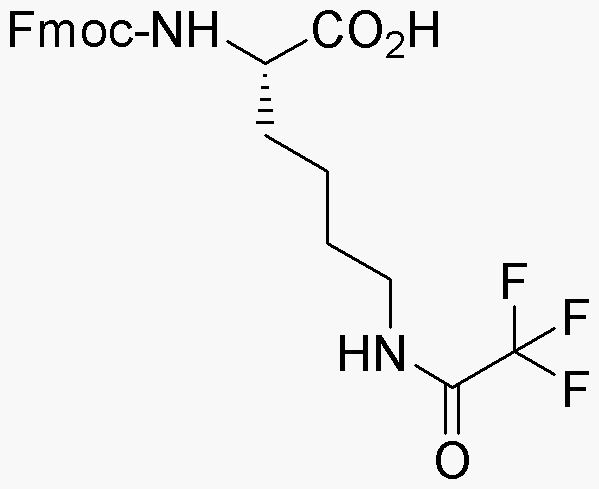Na-Fmoc-Ne-trifluoroacetyl-L-lysine is widely utilized in research focused on:
- Peptide Synthesis: This compound serves as a key building block in the synthesis of peptides, particularly in solid-phase peptide synthesis, enabling researchers to create complex peptide sequences efficiently.
- Drug Development: Its unique protective groups allow for selective reactions, making it valuable in the pharmaceutical industry for developing new therapeutic peptides with enhanced stability and bioactivity.
- Bioconjugation: The trifluoroacetyl group can be used to facilitate bioconjugation processes, allowing for the attachment of various biomolecules, which is essential in creating targeted drug delivery systems.
- Protein Engineering: Researchers utilize this compound in the modification of lysine residues in proteins, which can help in studying protein interactions and functions, ultimately aiding in the design of novel proteins.
- Analytical Chemistry: It is also employed in analytical methods for characterizing peptides and proteins, providing insights into their structure and function, which is crucial for quality control in biopharmaceuticals.
Informations générales
Propriétés
Sécurité et réglementation
Applications
Na-Fmoc-Ne-trifluoroacetyl-L-lysine is widely utilized in research focused on:
- Peptide Synthesis: This compound serves as a key building block in the synthesis of peptides, particularly in solid-phase peptide synthesis, enabling researchers to create complex peptide sequences efficiently.
- Drug Development: Its unique protective groups allow for selective reactions, making it valuable in the pharmaceutical industry for developing new therapeutic peptides with enhanced stability and bioactivity.
- Bioconjugation: The trifluoroacetyl group can be used to facilitate bioconjugation processes, allowing for the attachment of various biomolecules, which is essential in creating targeted drug delivery systems.
- Protein Engineering: Researchers utilize this compound in the modification of lysine residues in proteins, which can help in studying protein interactions and functions, ultimately aiding in the design of novel proteins.
- Analytical Chemistry: It is also employed in analytical methods for characterizing peptides and proteins, providing insights into their structure and function, which is crucial for quality control in biopharmaceuticals.
Documents
Fiches de données de sécurité (FDS)
La FDS fournit des informations de sécurité complètes sur la manipulation, le stockage et l’élimination du produit.
Spécifications du produit (PS)
Le PS fournit une description complète des propriétés du produit, notamment sa composition chimique, son état physique, sa pureté et les exigences de stockage. Il détaille également les plages de qualité acceptables et les applications prévues du produit.
Certificats d'analyse (COA)
Recherchez des certificats d'analyse (COA) en saisissant le numéro de lot du produit. Les numéros de lot et de lot se trouvent sur l'étiquette d'un produit, après les mots « Lot » ou « Lot de fabrication ».
Numéro de catalogue
Numéro de lot/série
Certificats d'origine (COO)
Ce certificat d'exploitation confirme le pays dans lequel le produit a été fabriqué, et détaille également les matériaux et composants utilisés et s'il est issu de sources naturelles, synthétiques ou autres sources spécifiques. Ce certificat peut être requis pour les douanes, le commerce et la conformité réglementaire.
Numéro de catalogue
Numéro de lot/série
Fiches de données de sécurité (FDS)
La FDS fournit des informations de sécurité complètes sur la manipulation, le stockage et l’élimination du produit.
DownloadSpécifications du produit (PS)
Le PS fournit une description complète des propriétés du produit, notamment sa composition chimique, son état physique, sa pureté et les exigences de stockage. Il détaille également les plages de qualité acceptables et les applications prévues du produit.
DownloadCertificats d'analyse (COA)
Recherchez des certificats d'analyse (COA) en saisissant le numéro de lot du produit. Les numéros de lot et de lot se trouvent sur l'étiquette d'un produit, après les mots « Lot » ou « Lot de fabrication ».
Numéro de catalogue
Numéro de lot/série
Certificats d'origine (COO)
Ce certificat d'exploitation confirme le pays dans lequel le produit a été fabriqué, et détaille également les matériaux et composants utilisés et s'il est issu de sources naturelles, synthétiques ou autres sources spécifiques. Ce certificat peut être requis pour les douanes, le commerce et la conformité réglementaire.


